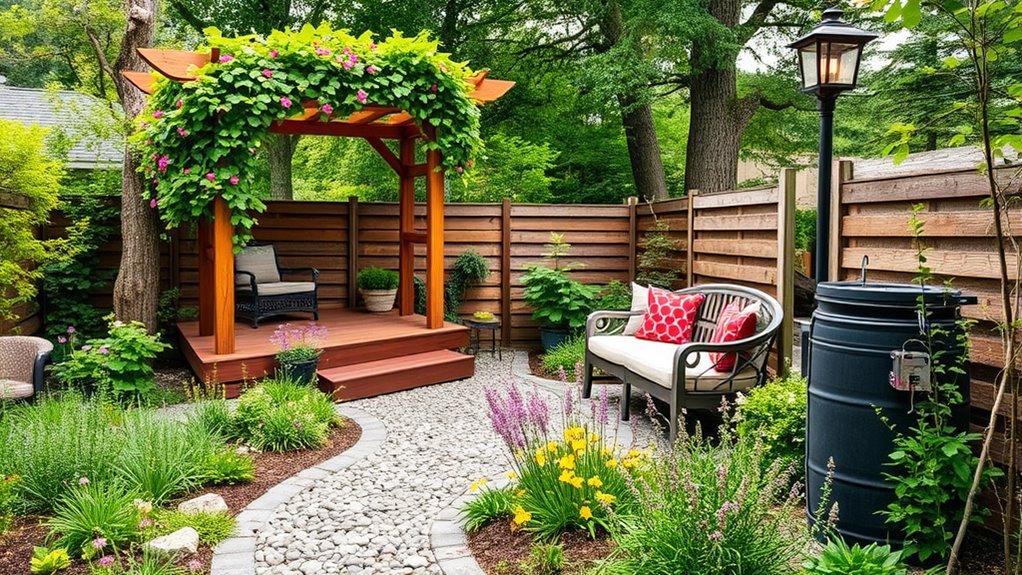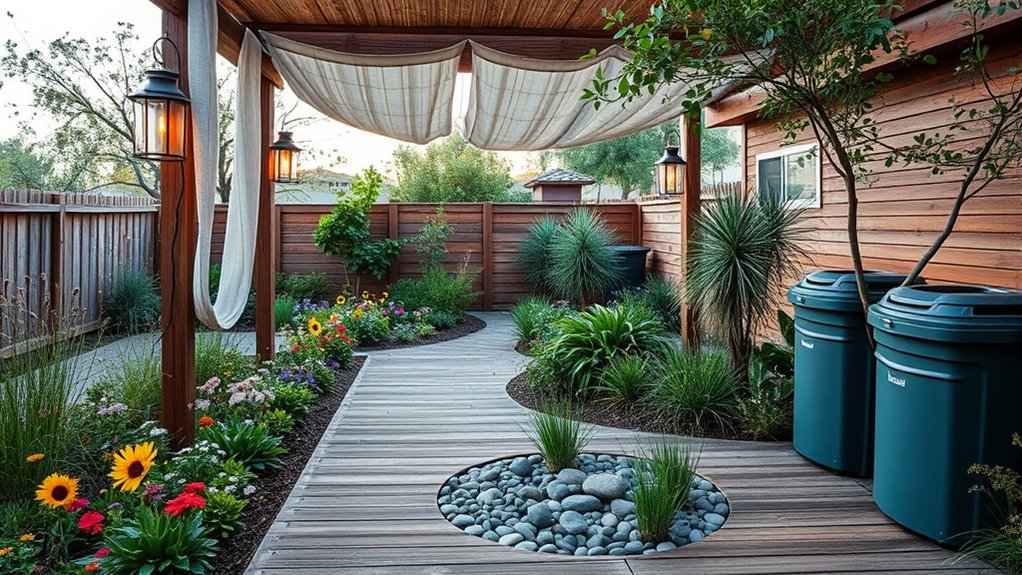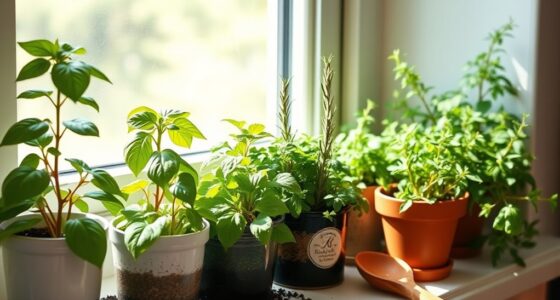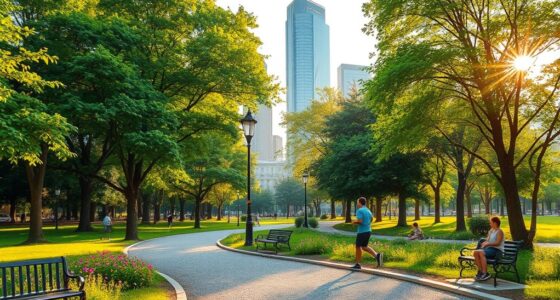To create a sustainable outdoor space, opt for native plants that thrive in your climate, needing less water and chemicals. Incorporate rain gardens to manage stormwater naturally and add visual interest with native flora. Choose eco-friendly materials for patios and focus on low-maintenance, biodiverse landscaping to support local wildlife. These practices make your yard eco-friendly, beautiful, and functional—continue exploring to discover how you can design a truly green outdoor area.
Key Takeaways
- Incorporate native plants to reduce water, fertilizer, and pesticide use while supporting local pollinators and biodiversity.
- Use rain gardens to manage stormwater naturally, prevent erosion, and recharge groundwater.
- Select permeable paving materials to improve drainage and minimize runoff.
- Design with eco-friendly features like composting areas and solar lighting to enhance sustainability.
- Maintain a balance of lush greenery and functional spaces to create visually appealing, low-impact outdoor environments.

Are you looking to create outdoor spaces that are both beautiful and environmentally responsible? Designing a sustainable patio or yard isn’t just about aesthetics; it’s about making choices that support local ecosystems and conserve resources. One effective way to do this is by incorporating native plantings into your landscape. Native plants are adapted to your region’s climate and soil, which means they require less water, fertilizers, and pesticides. They thrive naturally, attracting local pollinators like bees and butterflies, which helps sustain your area’s biodiversity. planting native species also reduces the need for ongoing maintenance, saving you time and money, while creating a lush, vibrant environment that feels truly connected to the land. Additionally, selecting the right plants can enhance the overall aesthetic of your outdoor space, making it both functional and visually appealing.
Alongside native plantings, rain gardens are a smart addition to any eco-friendly yard. These specially designed gardens absorb rainwater runoff from roofs, driveways, and lawns, preventing it from overwhelming storm drains and causing erosion or pollution in local waterways. By capturing and filtering rainwater on-site, rain gardens help reduce your home’s water footprint and promote healthy groundwater recharge. They can be both functional and attractive, featuring native plants that tolerate wet conditions, creating a natural-looking landscape that blends seamlessly with your yard. Installing a rain garden is a simple yet impactful way to manage stormwater sustainably, making your outdoor space more resilient and eco-conscious.
When you choose native plantings and rain gardens, you’re not only helping the environment but also creating a more inviting and low-maintenance outdoor space. Native plants provide year-round interest and support local wildlife, giving your yard a lively, natural feel. Rain gardens add visual appeal and serve as a gentle, eco-friendly way to handle excess water, preventing flooding and water pollution. These features also encourage sustainable practices, reducing the need for artificial irrigation and chemical treatments that can harm the environment. Incorporating sustainable landscaping practices can further enhance the eco-friendliness and beauty of your outdoor area.
Frequently Asked Questions
How Can I Incorporate Native Plants Into My Outdoor Design?
To incorporate native plants into your outdoor design, start with native plant selection suited for your climate and soil. Focus on ecological landscaping by choosing plants that support local wildlife and require less water and maintenance. Mix different native species to create diverse, resilient landscapes. Arrange them thoughtfully around your patio or yard, combining flowering plants, shrubs, and ground covers to enhance beauty and promote sustainability naturally.
What Are the Best Sustainable Materials for Outdoor Furniture?
You should consider using recycled plastics and bamboo furniture for your outdoor space. Recycled plastics are durable, weather-resistant, and help reduce waste, making them an eco-friendly choice. Bamboo furniture is sustainable, fast-growing, and adds a natural aesthetic. Both options require minimal maintenance and have a lower environmental impact, helping you create a stylish, sustainable outdoor area that’s good for the planet and resilient against the elements.
How Do I Reduce Water Usage in My Eco-Friendly Yard?
To reduce water usage in your eco-friendly yard, start by implementing rainwater harvesting systems to collect and reuse water efficiently. Plant drought-tolerant plants that require minimal watering, helping conserve resources. Mulch your garden beds to retain soil moisture and reduce evaporation. Additionally, use drip irrigation systems for targeted watering, and avoid overwatering. These steps make your yard more sustainable, saving water while maintaining a lush, healthy outdoor space.
What Are Effective Ways to Manage Stormwater Runoff Sustainably?
Imagine your yard as a sponge soaking up rain instead of flooding—this is how you manage stormwater runoff sustainably. You can create a rain garden design to absorb excess water and install permeable pavement to allow water to seep through, reducing runoff. These eco-friendly solutions help protect local waterways, prevent erosion, and promote a healthier landscape, turning your outdoor space into a model of sustainable stormwater management.
How Can I Create Wildlife Habitats in My Outdoor Space?
You can create wildlife habitats by incorporating bird-friendly landscaping and establishing wildlife corridors. Plant native trees, shrubs, and flowers to attract birds and pollinators, offering food and shelter. Design pathways that connect different areas of your yard to facilitate wildlife movement. Avoid pesticides and chemicals, and provide water sources like birdbaths. These efforts support local ecosystems, making your outdoor space a thriving habitat for various species.
Conclusion
By embracing eco-friendly ideas, you create a space that gently nurtures both nature and your well-being. Every thoughtful choice, from sustainable materials to native plants, helps foster a harmonious environment where beauty and balance thrive. Your outdoor space becomes more than just a yard; it’s a quiet sanctuary that offers solace and hope for a greener future. With each mindful step, you’re cultivating a haven that softly whispers of care and possibility.









